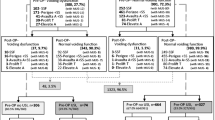Abstract
Introduction and hypothesis
The aim of this study is to investigate the risk factors of voiding dysfunction occurring within 1 month after surgical treatment of urinary incontinence.
Methods
Medical records of 903 women who underwent anti-incontinence surgery at Yonsei Medical Health System from January 1999 to April 2007 were reviewed. The patient demographics, urodynamic parameters, pelvic organ prolapse stage, surgical procedures, and concomitant surgery were retrospectively evaluated. Postoperative voiding dysfunction was defined as post-void residual urine measuring greater than 100 cc at two or more successive trials.
Results
Age, menopausal status, maximum flow rate, average flow rate, post-void residual, anti-incontinence surgery type, stage of pelvic organ prolapse, and concomitant prolapse surgery were associated predictors of voiding dysfunction after anti-incontinence surgery. In multivariate analysis, concomitant anterior colporrhaphy (OR 2.4; 95% CI 1.38–4.11) was the only independent risk factor.
Conclusions
The most important risk factor associated with voiding dysfunction was concomitant anterior colporrhaphy.
Similar content being viewed by others
References
Herzog AR, Fultz NH (1990) Prevalence and incidence of urinary incontinence in community dwelling populations. J Am Geriatr Soc 38:273–281
Hinoul P, Roovers JP, Ombelet W, Vanspauwen R (2009) Surgical management of urinary stress incontinence in women: a historical and clinical overview. Eur J Obstet Gynecol Reprod Biol 145:219–225
Sweeney DD, Leng WW (2005) Treatment of postoperative voiding dysfunction following incontinence surgery. Curr Urol Rep 6:365–370
Delorme E, Droupy S, de Tayrac R, Delmas V (2004) Transobturator tape (Uratape): a new minimally invasive procedure to treat female urinary incontinence. Eur Urol 45:203–207
deTayrac R, Deffieux X, Droupy S, Chauveaud-Lambling A, Calvanèse-Benamour L, Fernandez H (2004) A prospective, randomized trial comparing tension-free vaginal tape and transobturator suburethral tape for surgical treatment of stress urinary incontinence. Am J Obstet Gynecol 190:602–608
de Leval J (2003) Novel surgical technique for the treatment of female stress urinary incontinence: transobturator vaginal tape inside out. Eur Urol 44:724–730
Costa P, Grise P, Droupy S, Monneins F, Assenmacher C, Ballanger P et al (2004) Surgical treatment of female stress urinary incontinence with a trans-obturator tape (TOT) Uratape: short-term results of a prospective multicentric study. Eur Urol 46:102–107
Tsivian A, Kessler O, Mogutin B, Rosenthal J, Korczak D, Levin S et al (2004) Tape-related complications of the tension-free vaginal tape procedure. J Urol 171:762–764
Kuuva N, Nilsson CG (2002) A nationwide analysis of complications associated with the tension-free vaginal tape (TVT) procedure. Acta Obstet Gynecol Scand 81:72–77
Klutke C, Siegel S, Carlin B, Paszkiewicz E, Kirkemo A, Klutke J (2001) Urinary retention after tension-free vaginal tape procedure: incidence and treatment. Urology 58:697–701
Abouassaly R, Steinberg JR, Lemieux M, Marois C, Gilchrist LI, Bourque JL et al (2004) Complications of tension-free vaginal tape surgery: a multi-institutional review. BJU Int 94:110–113
Bodelsson G, Henriksson L, Osser S, Stjernquist M (2002) Short-term complications of the tension-free vaginal tape operation for stress urinary incontinence in women. BJOG 109:566–569
Bump RC, Mattiasson A, BØ K, Brubaker LP, DeLancey JO, Klarskov P et al (1996) The standardization of terminology of female pelvic organ prolapse and pelvic floor dysfunction. Am J Obstet Gynecol 175:10–17
Cross CA, Cespedes RD, McGuire EJ (1998) Our experience with pubovaginal slings in patients with stress urinary incontinence. J Urol 159:1195–1198
Ulmsten U, Henriksson L, Johnson P, Varhos G (1996) An ambulatory surgical procedure under local anesthesia for treatment of female urinary incontinence. Int Urogynecol J Pelvic Floor Dysfunct 7:81–86
Delorme E (2001) Transobturator urethral suspension: mini-invasive procedure in the treatment of stress urinary incontinence in women. Prog Urol 11:1306–1313
Serati M, Salvatore S, Uccella S, Artibani W, Novara G, Cardozo L et al (2009) Surgical treatment for female stress urinary incontinence: what is the gold-standard procedure? Int Urogynecol J Pelvic Floor Dysfunct 20:619–621
Ulmsten U, Petros P (1995) Intravaginal slingplasty (IVS): an ambulatory surgical procedure for treatment of female urinary stress incontinence. Scand J Urol Nephrol 29:75–82
Bai SW, Jeon MJ, Kim JY, Chung KA, Kim SK, Park KH (2002) Relationship between stress urinary incontinence and pelvic organ prolapse. Int Urogynecol J Pelvic Floor Dysfunct 13:256–260
Jeon MJ, Kim SK, Bai SW (2007) Concomitant pelvic reconstructive surgery and transobturator tape for SUI. Int J Gynaecol Obstet 96:47–48
Lo TS, Chang TC, Chao AS, Chou HH, Tseng LH, Liang CC (2003) Tension-free vaginal tape procedure on genuine stress incontinent women with coexisting genital prolapse. Acta Obstet Gynecol Scand 82:1049–1053
Mutone N, Brizendine E, Hale D (2003) Factors that influence voiding function after the tension-free vaginal tape procedure for stress urinary incontinence. Am J Obstet Gynecol 188:1477
Lasala CA (2003) Incomplete bladder emptying after the tension-free vaginal tape procedure, necessitating release of the mesh. A report of three cases. J Reprod Med 48:387–390
Sze EH, Miklos JR, Karram MM (1996) Voiding after Burch colposuspension and effects of concomitant pelvic surgery: correlation with preoperative voiding mechanism. Obstet Gynecol 88:564–567
Iglesia CB, Shott S, Fenner DE, Brubaker L (1998) Effect of preoperative voiding mechanism on success rate of autologous rectus fascia suburethral sling procedure. Obstet Gynecol 91:577–581
Nguyen JK (2002) Diagnosis and treatment of voiding dysfunction caused by urethral obstruction after anti-incontinence surgery. Obstet Gynecol Surv 57:468–475
Stanton SL, Cardozo L, Chaudhury N (1978) Spontaneous voiding after surgery for urinary incontinence. Br J Obstet Gynaecol 85:149–152
Weinberger MW, Ostergard DR (1996) Postoperative catheterization, urinary retention, and permanent voiding dysfunction after polytetrafluoroethylene suburethral sling placement. Obstet Gynecol 87:50–54
Sokol AI, Jelovsek JE, Walters MD, Paraiso MF, Barber MD (2005) Incidence and predictors of prolonged urinary retention after TVT with and without concurrent prolapse surgery. Am J Obstet Gynecol 192:1537–1543
Kleeman S, Goldwasser S, Vassallo B, Karram M (2002) Predicting postoperative voiding efficiency after operation for incontinence and prolapse. Am J Obstet Gynecol 187:49–52
Conflicts of interest
None.
Author information
Authors and Affiliations
Corresponding author
Rights and permissions
About this article
Cite this article
Chung, SM., Moon, YJ., Jeon, MJ. et al. Risk factors associated with voiding dysfunction after anti-incontinence surgery. Int Urogynecol J 21, 1505–1509 (2010). https://doi.org/10.1007/s00192-010-1229-7
Received:
Accepted:
Published:
Issue Date:
DOI: https://doi.org/10.1007/s00192-010-1229-7



